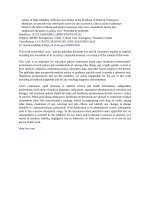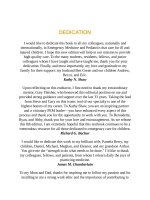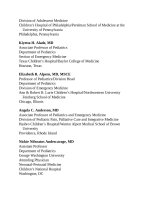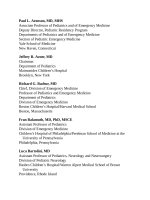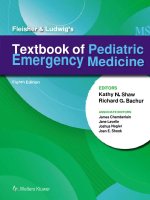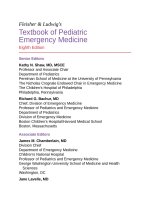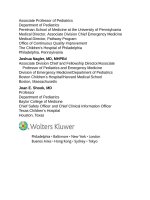Pediatric emergency medicine trisk 0231 0231
Bạn đang xem bản rút gọn của tài liệu. Xem và tải ngay bản đầy đủ của tài liệu tại đây (101.64 KB, 1 trang )
guidelines or infant (PALS) guidelines can be appropriate and there is currently
no evidence for a specific age to transition from one to the other. Hospital or
agency policy should be established which leans on the expertise of the unit to
ensure high-quality CPR is delivered regardless of algorithm followed.
Though rare, the ED team must be prepared for the resuscitation of the newly
born infant. Fortunately, 90% of neonates transition from intrauterine to
extrauterine life without resuscitative needs beyond simple warming and
stimulation. However, the remaining 10% requires some assistance, and 1% will
require extensive resuscitative measures, such as cardiac compressions and
medications. Resuscitative needs vary greatly by gestational age and birth weight.
Approximately 6% of term newborns will require resuscitation at birth, as will
nearly 80% of infants who weigh less than 1,500 g. Given that anticipation of a
high-risk birth in the ED setting is not always feasible, successful newborn
resuscitation for the ED team hinges on readiness of staff and equipment.
EMERGENCY DEPARTMENT READINESS
Education of staff, necessary equipment, and specific policies and procedures are
critical for ED readiness. Early notification, when feasible, allows time to
assemble key personnel. Each institution should have a procedure in place for
rapidly mobilizing a team with complete newborn resuscitation skills for any
birth. In addition to a standard obstetric tray, every ED should have a newborn
resuscitation kit that is readily accessible, maintained, and rapidly restocked after
use. Necessary equipment and medications are listed in Table 9.8 . A radiant
warmer and medication dosing chart are critical. A standardized checklist is
recommended to ensure that all necessary equipment and supplies are present and
functional. Because neonatal resuscitations in the ED are uncommon, simulation
scenarios at regular intervals allow staff to remain familiar with neonatal
resuscitation skills and supplies. Most births that occur outside of the delivery
room have high-risk components such as trauma-induced labor and unexpected
pregnancy. Important historical factors include prematurity, multiple gestation,
meconium-stained amniotic fluid, and maternal drug use. The team can then
anticipate the need for assisted ventilation, simultaneous resuscitations, tracheal
suctioning, or pharmacologic interventions.
PATHOPHYSIOLOGY
The fetal heart has two large right-to-left shunts: from the right atrium to the left
atrium through the foramen ovale, and from the pulmonary artery to the aorta
across the ductus arteriosus. At birth, two major changes occur that eliminate
these shunts: the umbilical cord is clamped, and spontaneous respirations are
